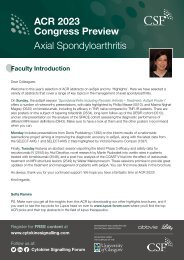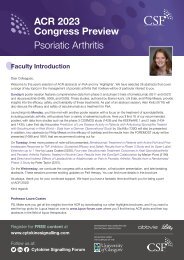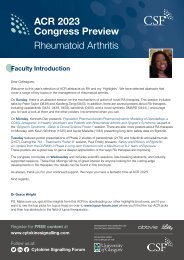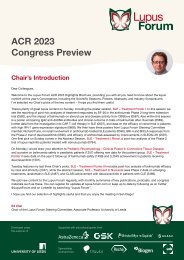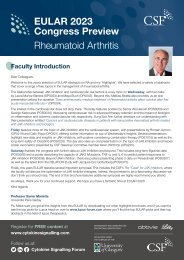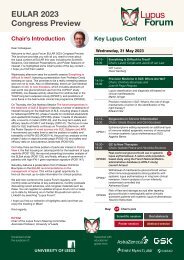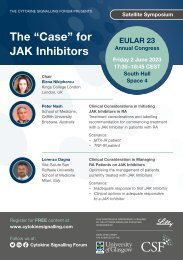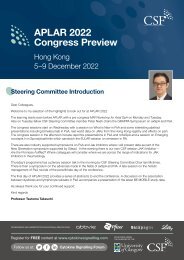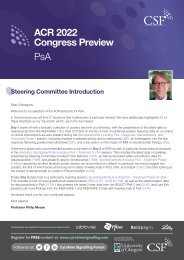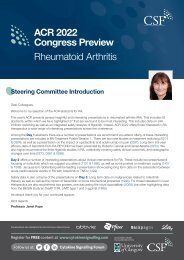ACR Congress Review 2019
Create successful ePaper yourself
Turn your PDF publications into a flip-book with our unique Google optimized e-Paper software.
Update on JAK inhibitor safety data<br />
Upadacitinib<br />
Upadacitinib safety in the SELECT clinical program<br />
Findings from an integrated analysis of the upadacitinib safety profile from the SELECT Phase 3 clinical<br />
program were presented in three posters.<br />
Cohen and colleagues presented exposure-adjusted event rates (EAERs) and key safety data. Across<br />
the five Phase 3 trials, 3834 patients received one or more dose of upadacitinib 15 (n=2630) or 30 mg<br />
QD (n=1204). The EAERs of overall SAEs and AEs leading to discontinuation on upadacitinib 15 mg<br />
were comparable to adalimumab; while the rates of both were higher on upadacitinib 30 versus<br />
upadacitinib 15 mg and MTX. Rates of deaths were comparable across the treatment groups. Serious<br />
infection rates were comparable between upadacitinib 15 mg and adalimumab, while higher on<br />
upadacitinib compared with MTX. Rates of herpes zoster were higher in both upadacitinib groups versus<br />
MTX and adalimumab. The rates of serious infections and herpes zoster were higher on upadacitinib 30<br />
versus 15 mg. Rates of VTE, MACE, and malignancy were comparable with that observed in the MTX<br />
and adalimumab groups while also being consistent with reported rates in the RA population [509*].<br />
Choy and colleagues presented an analysis focusing on MACE and VTE. The EAERs of MACE and<br />
VTE in the upadacitinib groups were comparable to placebo, MTX and adalimumab. Approximately 40%<br />
of MACEs and 1 PE event (upadacitinib 15 mg) were fatal. All patients with a MACE or VTE event had<br />
one or more CV risk factors (hypertension, diabetes, dyslipidaemia) or one or more VTE risk factor (prior<br />
history of thrombotic event, obesity, or hypertension) at baseline, respectively. Treatment with<br />
upadacitinib increased the levels of LDL-C and HDL-C, however, their ratio remained constant over time<br />
and there was no association of LDL‐C increases and MACE occurrences. No dose‐response or pattern<br />
of time-to-VTE-onset was observed with either upadacitinib dose [846*].<br />
An integrated, long-term safety analysis of upadacitinib in Japanese patients was presented by<br />
Yamaoka and colleagues. The analysis included a total of 371 Japanese patients who received<br />
upadacitinib 7.5 (n=121), 15 (n=126), or 30 mg QD (n=124) in one of three clinical studies (SELECT-<br />
SUNRISE, SELECT-EARLY or SELECT-MONOTHERAPY). Among the Japanese population, EAERs<br />
were consistently higher in the 30 mg group compared with the 15 mg and 7.5 mg groups. EAERs in the<br />
15 mg and 7.5 mg groups were comparable. In comparison with the global population, EAERs in the 15<br />
mg and 30 mg groups was higher in the Japanese population. The EAER of infections (including herpes<br />
zoster) was also higher in the Japanese population compared with the global population. In contrast,<br />
EAERs of AESI (including malignancies, cardiovascular disorders, hepatic disorders, and laboratory<br />
abnormalities) were comparable between the Japanese and global populations [2407].<br />
Baricitinib<br />
Long-term baricitinib safety in RA<br />
The long-term safety and efficacy profile for baricitinib up to 7 years was presented by Genovese et al.<br />
The analysis included 3770 patients with RA (10,127 patient-years of exposure) from 9 randomised trials<br />
and an ongoing open-label, long-term extension study. No significant differences were seen for<br />
baricitinib 4 mg versus placebo in AEs leading to permanent drug discontinuation, death, malignancy,<br />
serious infection, or MACE. The incidence rate of herpes zoster was significantly higher for baricitinib<br />
4 mg versus placebo (3.8 versus 0.9) and numerically higher for baricitinib 2 mg (3.1). Incidence rates<br />
for DVT/PE were numerically higher in baricitinib 4 mg versus placebo. Malignancy (excluding<br />
*Chairman’s Pick



